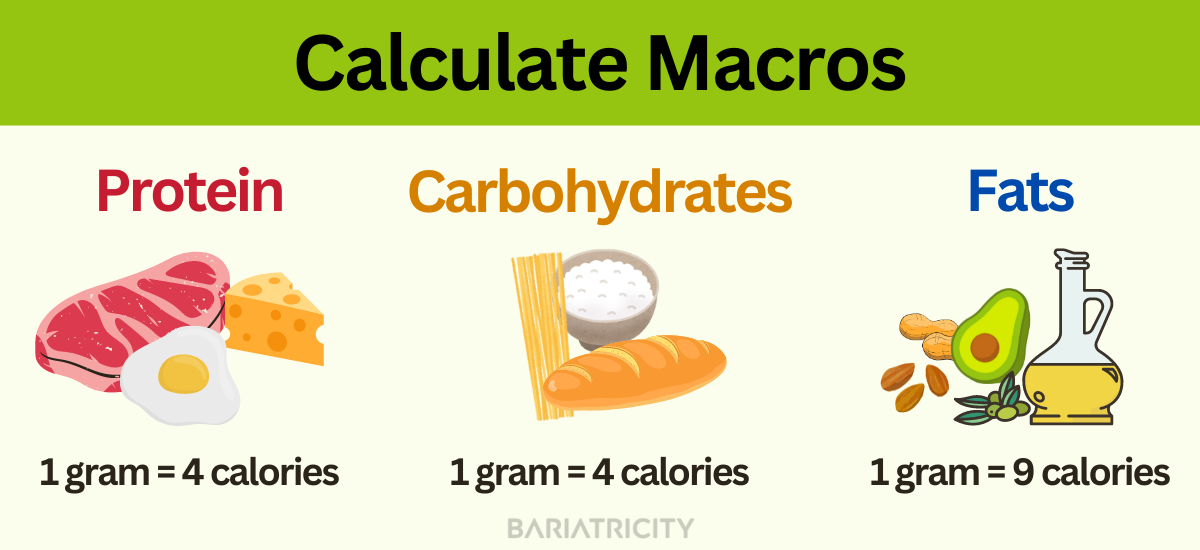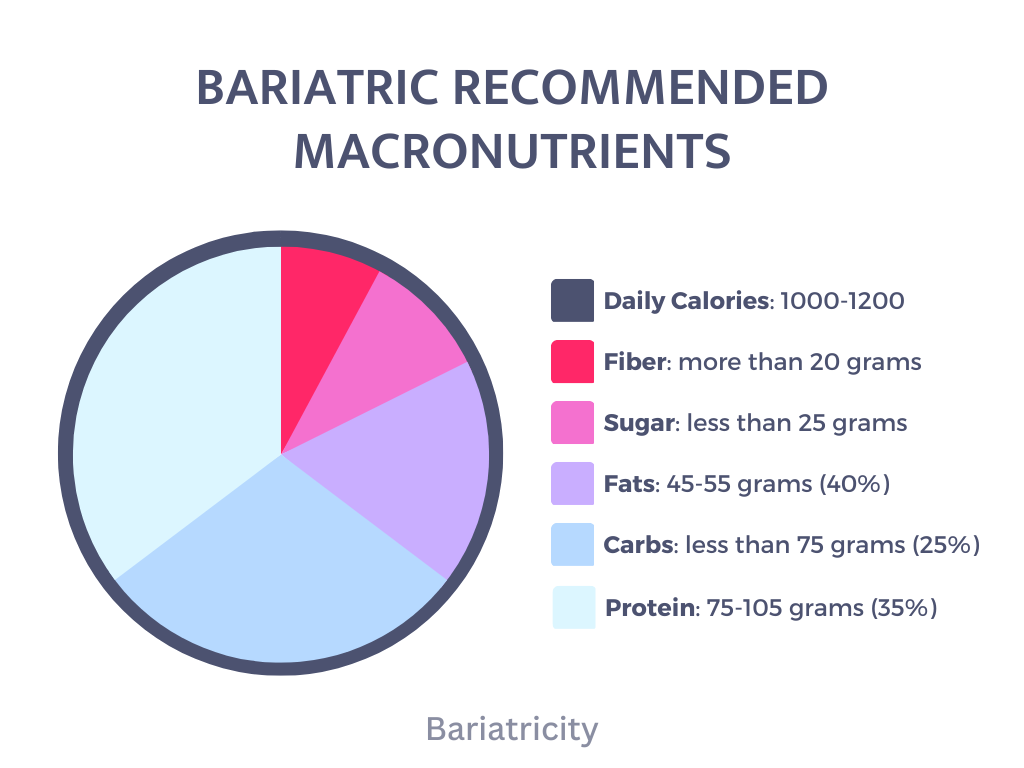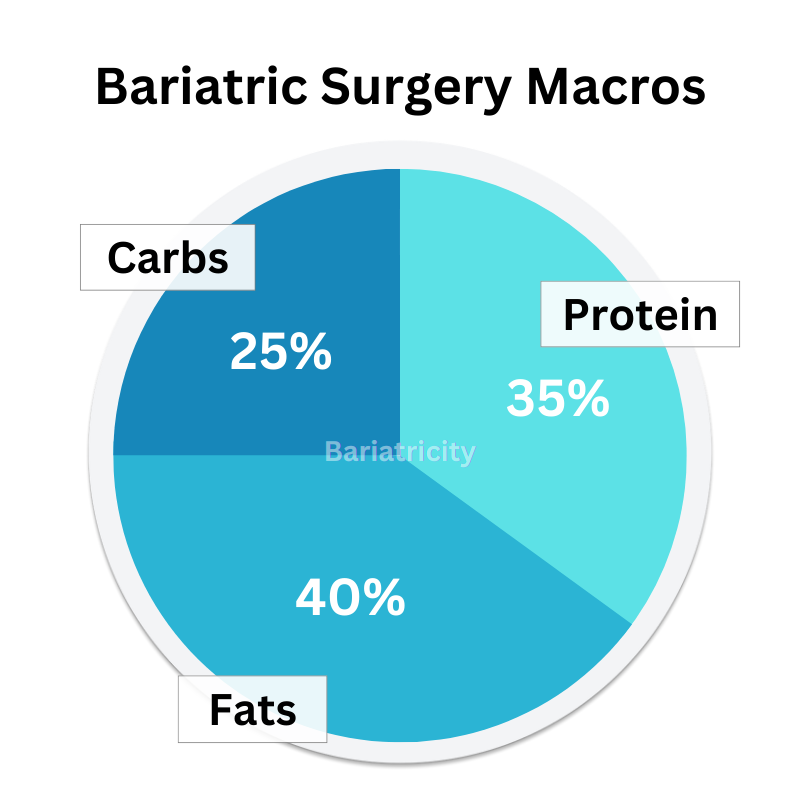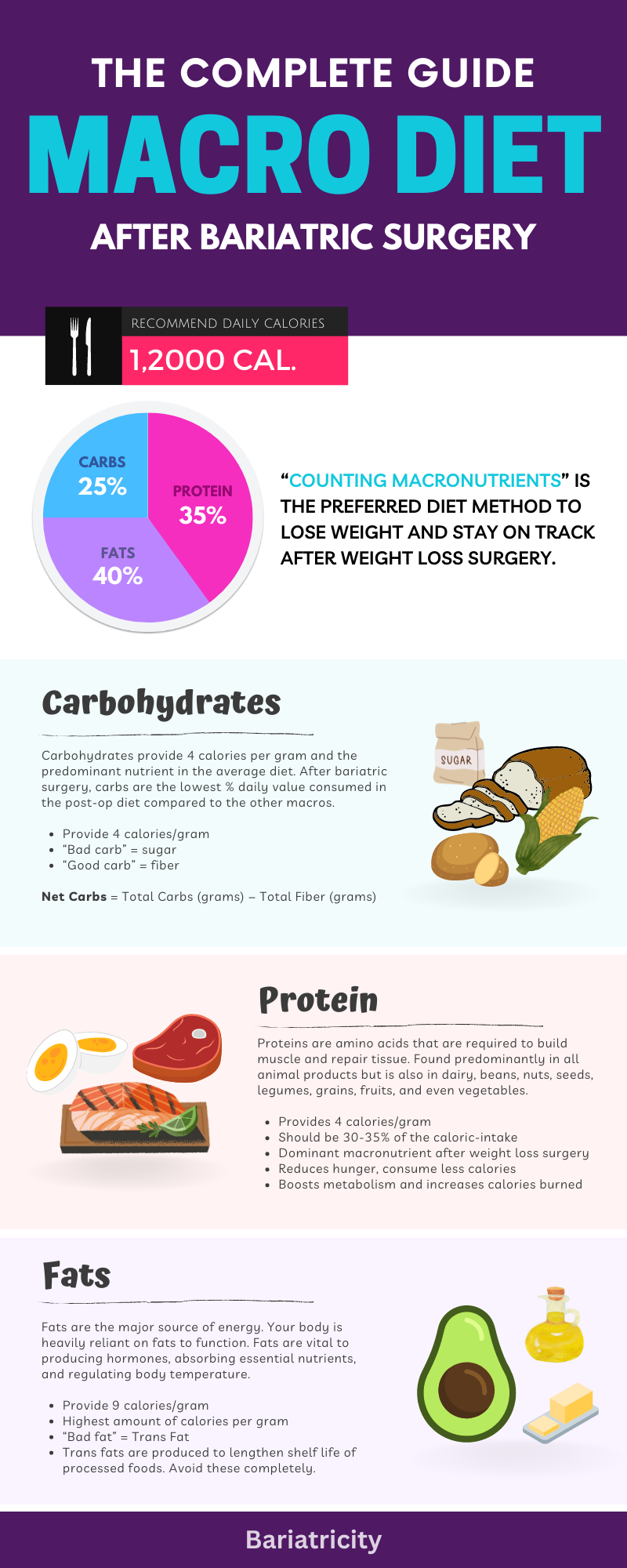“Counting macros” is the preferred diet to lose weight, reach your goal weight, and stay on track after weight loss surgery.
The objective of the macronutrient-based diet is to completely optimize your caloric-intake to the most nutrient dense foods. Instead of the constant obsession of restricting calories like most diet programs, you will focus on eating the right calories of nutrient-rich foods.
What are Macronutrients?
Macronutrients make up everything we eat. There are three types of macronutrients; Protein, Carbohydrates, and Fats.
All of these macronutrient components provide calories and energy that our bodies need to function. Counting macros forces you to make healthier diet choices without stressing as much the amount of food you eat.
Carbohydrates
Carbohydrates are the sugar, starches, and fibers found in the foods we eat. Your brain, muscles, and cells all depend on need carbohydrates to function and fuel your body. Carbohydrates provide 4 calories per gram and the predominant nutrient in the average diet. After weight loss surgery, carbs will be the lowest % daily value consumed in the post-op diet compared to the other macros.
- 1 gram = 4 calories
- “Bad carb” = sugar
- “Good carb” = fiber
- “Net Carbs” = Total Grams Carbohydrates − Total Grams Fiber
- Healthy carbs: Whole grains, vegetables, beans, legumes, and unprocessed foods.
- Unhealthy carbs: White bread, cookies, candy
Proteins
Proteins are amino acids that are required to build muscle and repair tissue. Found predominantly in all animal products but is also in dairy, beans, nuts, seeds, legumes, grains, fruits, and even vegetables.
- 1 gram = 4 calories
- Should be 30-35% of the caloric-intake
- The dominant macronutrient after weight loss surgery
- Reduces hunger, causing you to consume less calories
- Boosts metabolism and therefore increases calories burned
- Healthy proteins: Fish (salmon), chicken, turkey, eggs, legumes
- Unhealthy proteins: Red meats, beef jerky, canned tuna
Fats
Fats are the major source of energy. Your body is heavily reliant on fats to function. Fats are vital to producing hormones, absorbing essential nutrients, and regulating body temperature.
- 1 gram = 9 calories
- Highest amount of calories per gram
- “Bad fat” = Trans Fat
- Trans fats are produced by food companies to lengthen shelf life of processed foods. Avoid these completely.
- Healthy fats: Vegetable oils, amino acids, avocado, nuts, seeds, meat, and fatty fish
- Unhealthy fats: Butter, trans fat, whole milk, fatty meat, lard, coconut oil
Other Components: In addition to the three macronutrients, one more component provides calories and that is alcohol. Alcohol is not considered a macronutrient. Keep track of calorie-intake as it provides 7 calories/gram.

How to Count Macros
One of the most efficient ways to lose weight is to set goals for your macros. This allows you to eat the foods you want (nothing is completely off limits) as long as they fall in your macro goals for the day.
Here are the 3 easy steps to counting macros after weight loss surgery.
Step 1. Determine Your Macro Count
Below are the macronutrient goals we recommend for a post-op gastric sleeve and gastric bypass patient who is beyond the healing, recovery, and transitioning stages (after 2 months post-op surgery).
*Your daily calorie intake may be different based on your individual needs, nutritionist, and/or doctor recommendations.
Macronutrient Goals and Recommendations:
Here is what we recommend your macros should be after gastric sleeve or gastric bypass surgery.
- Daily Calories: 1000-1200
- Carbs: less than 75 grams (25%)
- Protein: 75-105 grams (35%)
- Fats: 45-55 grams (40%)
- Sugar: less than 25 grams
- Fiber: more than 20 grams
Step Two: Tracking Macros
You can easily set macronutrient goals through using an app like MyFitnessPal. An app will have most food products in their database and do all the math for you.
Step Three: Counting Macros (with Example)
Example: How to count macronutrients for a 1,200-calorie daily diet consisting of 25% carbs, 35% protein, and 40% fats (the recommended macro breakdown).
Counting Carbs
- Count 4 calories/gram
- Calories: 1,200
- Carbohydrates: 25%
- Carb calories: 25% × 1,200 calories = 300 calories of carbs
- Counting carbs: There are 4 calories per gram. Divide 300 by 4 calories/gram
- 300 / 4 = 75 grams
Hint: If you are counting what is referred to as “net carbs” you will then subtract the grams of fiber you consumed from the grams of carbohydrates.
Counting Protein
- Count 4 calories/gram
- Calories: 1,200
- Protein: 35%
- Protein calories = 35% × 1200 calories = 420 calories of protein
- Counting protein: There are 4 calories per gram. Divide 420 by 4 calories/gram
- 420 / 4 = 105 grams
Counting Fats
- 9 calories/grams
- Calories: 1,200
- Fat: 40%
- Fat calories = 40% × 1,200 calories = 480 calories of fat
- Counting fat: There are 9 calories per gram. Divide 480 calories of fat by 9
- 480 / 9 = 53.3 grams
Starting a Macro Diet Meal Plan
So what is the best macro meal plan for gastric sleeve and bypass patients?
Breakfast: Protein smoothie – 1 serving protein powder with 30 grams of protein, 1⁄2 banana, 1 cup unsweetened cashew milk, 1 tbsp. benefiber powder, ice to desired thickness
Snack: Cheese stick, 15 almonds
Lunch: 3 oz. cooked salmon, 1 tbsp. olive oil, 2 oz. cooked green beans
Snack: Triple Zero Greek yogurt, ¼ cup blueberries
Dinner : 3 oz. cooked chicken thigh, ¼ cup pinto beans, ¼ medium avocado
Snack: Sugar-free chocolate pudding
Totals Macro Count
- Calories: 1160
- Protein: 101 grams
- Fat: 58 grams
- Total Carbs: 77 grams
- Total Fiber: 25 grams
- Net Carbs: (Total carbs − fiber) = 52 grams
Takeaway of Macro Diet
Please note we have offered our general recommendations for macronutrient goals above but there is no one-size-fits-all. These goals can be altered and arranged to meet your goals depending on the type of diet you want to follow.
For example, if you want to do a strict keto diet, you would alter the percentages so that you are getting 5-10% carbs, 60-75% fat, and 15-30% of calories from protein. Or perhaps you are someone who exercises or works out and needs more carbohydrates for energy.
- Use an app like MyFitnessPal, which makes calculating macros much easier.
- Stick to what you know! If anything is too drastic for you, start slow and gradually build to a healthy macro count and ideal ratio.
- Try to find your ideal macro ratio. This plan is a sample for the average gastric sleeve patient, who have fully healed, and at least 4 weeks post-op.
- Always ask your nutritionist or doctor their opinion and if it is recommended for you.
- Feel free to contact us if you need additional help from our nutritionist.





![Bariatric Surgery Post-Op Diet [Nutritionist Approved] 8 Bariatric Surgery Post-Op Diet Guidelines](https://bariatricity.com/wp-content/uploads/2018/07/Bariatric-Surgery-Post-Op-Diet-Guidelines-1024x576.png)